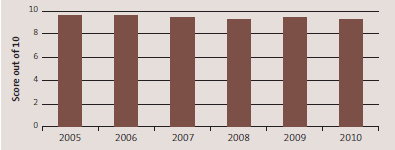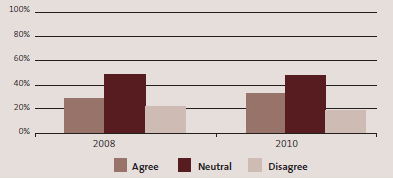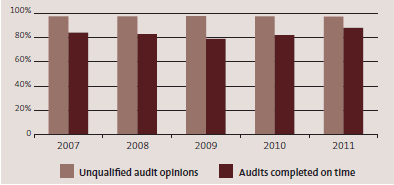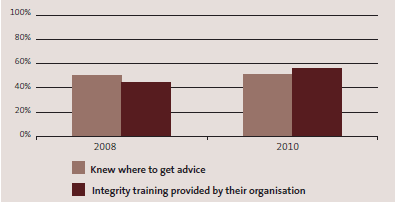Part 1: Background
Nature and scope of the Auditor-General's functions
The Controller and Auditor-General (the Auditor-General) is an Officer of Parliament who carries out her role independent of executive government and Parliament, but is accountable to Parliament for the public resources she uses to do the job.
By law, the Auditor-General is the auditor of all public entities in New Zealand – a total of about 4000 public entities, such as government departments, Crown entities, schools, and State-owned enterprises.
All public entities are accountable for their use of public resources and powers. It is the Auditor-General's job to give Parliament and the public independent assurance about how public entities are operating and accounting for their performance.
The role also includes auditing local authorities, which are accountable to the public for the activities they fund through locally raised revenue. As well as annual audits, the Auditor-General audits local authorities' long-term plans, which are prepared every three years.
By carrying out audits and reporting audit findings, the Auditor-General draws attention to matters of effectiveness and efficiency, waste, probity, and financial prudence. She recommends actions to help improve public sector performance and the reporting of performance information to Parliament and the public.
The Public Audit Act 2001 sets out the mandate and responsibilities of the Auditor-General. The Auditor-General's legislative mandate is confined to public entities, for which the Auditor-General:
- must carry out the annual audit requirements of the Public Audit Act 2001 and other statutes (such as the Public Finance Act 1989 and Local Government Act 2002, which set out accountability responsibilities of public entities);
- may carry out other services of a kind that it is reasonable and appropriate for an auditor to perform; and
- may carry out performance audits and inquiries.
Strategic directions and operating intentions
The Auditor-General's vision is to improve the performance of, and the public's trust in, the public sector. In the medium term, her strategy is to generate greater insight and value from our work by improving our understanding of the public entities we audit, using the full range of our resources, customising our reporting, and improving the overall capability and engagement of our staff.
Figure 1
Summary of our outcomes, impacts, and outputs

Main measures and standards for achieving our outcomes
Our measure for the degree of trust in the public sector is that New Zealand's score in the annual Transparency International Corruption Perceptions Index is maintained or improved during the next three years.
We assessed progress towards our intermediate outcomes by using information that we gather:
- during the course of delivering our services; and
- through the results of research commissioned by the State Services Commission (SSC) – specifically, the Integrity and Conduct Survey1 and the Kiwis Count Survey.2
Our assessment is that our outcomes were maintained or improved during the last year, with:
- New Zealand's 2010 Transparency International Corruption Perceptions Index score being 9.3, which ranked New Zealand first equal with Denmark and Singapore; and
- Maintained or improved results being shown in all the indicator areas for our intermediate outcomes as set out below.
Figure 2
Main measures and standards for achieving our outcomes
| Measures and standards | Previous performance |
|---|---|
| Trusted public sector | New Zealand's score on the Transparency International Corruption Perceptions Index for the six years from 2005 to 2010 In 2010, New Zealand was rated first equal with Denmark and Singapore. New Zealand has achieved a high place on the index since it started in 1995. |
| New Zealand's score on Transparency International's Corruption Perceptions Index is maintained or improved. | |
| Trusted public sector | New Zealand's ranking in the Worldwide Governance Indicators for the five years from 2006 to 2009  |
| New Zealand is ranked in the 90th percentile of the Worldwide Governance Indicators. | |
| Trusted public sector | Kiwis Count Survey results in 2008 and 2010: Public servants do a good job  |
| The State Services Commission's biannual Kiwis Count Survey shows that the public's confidence that public servants do a good job is improved (or at least maintained). | |
| Appropriately responsible public sector behaviour | Percentage of unqualified audit opinions and audits completed on time in the five years from 2007 to 2011  |
| Public entities' financial statements fairly reflect their actual results and are publicly available on time. | |
| Appropriately responsible public sector behaviour | Integrity and Conduct Survey results for 2008 and 2010: State service agencies that promote their standards of integrity and conduct |
| The State Services Commission's Integrity and Conduct Survey shows improved (or at least maintained) rates of State servants who reported that State service agencies promote their standards of integrity and conduct. | |
| Appropriately responsible public sector behaviour | Integrity and Conduct Survey results in 2008 and 2010: State servants' observation and reporting of misconduct |
| The State Services Commission's Integrity and Conduct Survey shows improved (or at least maintained) rates of State servants who reported that, where they observed misconduct breaches in the past year, they reported it. |  |
| High-performing public sector | Kiwis Count Survey results in 2008 and 2010: Most recent public service experience was an example of good value for tax dollars spent  |
| The State Services Commission's biannual Kiwis Count Survey shows improved (or at least maintained) rates of respondents reporting that their most recent public service experience was an example of good value for tax dollars spent. | |
| High-performing public sector The State Services Commission's biannual Kiwis Count Survey* shows improved (or at least maintained) rates of public satisfaction with:
|
There were methodology changes in the Kiwis Count Survey between 2008 and 2010, which mean that the results are not directly comparable. However, the results in 2010 confirmed that satisfaction with the public's most recent public service experience had improved, and that the public's experiences with public services continue to be rated better than experiences with non-government services. |
* The 2009/10 survey results for experience of public services compared with non-government services were reported differently to those of the 2007/08 survey. In 2009/10, the results were reported as the mean score from responses collected on a five-point scale (0, 25, 50, 75, and 100).
Strategic risks and risk management
The Auditor-General faces four ongoing strategic risks. These risks are primarily managed through processes that support the work we do, as shown in Figure 3.
Throughout the 2010/11 year, the Office continued its focus on managing risks, particularly strategic risks. The leadership team discusses these quarterly, including assessing any environmental or internal changes that may affect the Office's position. The Audit and Risk Committee receives a report quarterly and provides additional insight and advice to the Office regarding the strategic risks. The Committee's own report for 2010/11 is on pages 18–19.
Figure 3
Our strategic risks and risk management
| Risk | Management |
|---|---|
| 1. Loss of independence – Independence underpins the value of the Auditor-General's products. Losing that independence in fact or appearance, whether by failure on the part of the Auditor-General, her staff, or her appointed auditors to act independently or otherwise, would undermine trust in our organisation. | We manage this risk by applying the Auditor-General's independence standards. The Auditor-General sets a high standard for independence for her employees and the auditors she appoints to carry out audits on her behalf. Monitoring of the independence standards, including for the two statutory officers and all employees, is carried out through a system that includes regular declarations of interest and, where necessary, implementing measures to mitigate conflicts of interest. Senior managers in the Office monitor and regularly assess any factors that may threaten auditor independence. We identified a small number of such factors throughout the year, but are satisfied that the Office has appropriate plans to reduce the effect of these factors to an acceptable level. |
| 2. Audit failure – the risk that we issue an incorrect audit opinion with material effect, or a report that is significantly wrong in nature or process. | The Auditor-General adhered to professional auditing standards, including implementing and complying with the revised quality control standards from the New Zealand Institute of Chartered Accountants. These standards were supplemented by the Auditor-General's auditing standards to address public sector matters where general auditing standards were not relevant or appropriate. A range of audit opinion and consistency review processes were used to confirm audit team conclusions where non-standard audit opinions were proposed, or changes to audit standards and work were being introduced. All annual audits of more than 500 hours, or otherwise considered to be high risk, were subject to engagement quality control review before the audit opinion was issued. We monitored adherence to the Auditor-General's auditing standards, which incorporate professional auditing standards, through external quality assurance regimes (such as participating in New Zealand Institute of Chartered Accountants' practice reviews and, from time to time, international peer reviews). Our internal quality control procedures included carrying out quality assurance reviews of all our appointed auditors and our Office products on a risk basis and to ensure reviews of all auditors and products over a three-year period. We also commissioned an independent external review of two performance audits, and stakeholder feedback studies. Before performance audits are presented to Parliament, a process of external report clearance and internal substantiation and review is observed. |
| 3. Loss of capability – the risk that we are unable to retain, recruit, or access people with the technical and other skills our audit work requires. | Ongoing training and development of our staff and our appointed auditors and their staff is carried out, including management programmes, leadership development initiatives, and professional development programmes. As an Approved Training Organisation for Chartered Accountants, the Office continued to attract high-quality people into our graduate programme. This year, 97% of our employees sitting the NZ Institute of Chartered Accountants final professional exams were successful. |
| 4. Loss of reputation – the risk that we lose reputation or credibility that affects our ability to maintain effective relationships with stakeholders. This could arise either because of failings in one of the three risk areas listed above or because of external expectations and perceptions about the role of the Office or its findings on any particular matter that has been the subject of audit scrutiny. The Auditor-General's discretionary mandate is broad, and it is inevitable that we will not meet all expectations. | Managing this risk requires the exercise of judgement about where to focus our audit effort and how best to report while also achieving the greatest likelihood of public sector improvement. There were a number of ways this risk was managed in our day-to-day work. The combined leadership team of the Office met on a regular basis to discuss issues and feedback from key stakeholders and public entities on our audit work. Senior staff liaised with public entities and key stakeholders, and we carried out regular stakeholder and client feedback surveys as well as media monitoring to identify where the Office could communicate more effectively about its role and the results of its audit work. We also commissioned each year an independent evaluation of our audit allocation and fee monitoring processes. Feedback from both the stakeholder and client surveys, as well as from individual stakeholder meetings, indicate that the reputation of the Office remains sound. |
Report of the Audit and Risk Committee
for the year to 30 June 2011
| Members: John Hagen MBA, MCom, FCA, Investigating accountant – Chairman Kerry Prendergast MBA, NZRN, NZRM, CNZM, Director (from 1 March 2011) Stephen Revill BA, LLB (to 7 December 2010) Phillippa Smith BA, LLB, MPP, Deputy Controller and Auditor-General Neil Walter MA, CNZM, Director |
The Audit and Risk Committee is an independent committee established by, and reporting directly to, the Auditor-General. The Committee was established in 2003, as the Audit Committee. The reference to risk was included in the name of the Committee in December 2005, to better describe the Committee's role.
The purpose of the Committee is to oversee:
- risk management and internal control;
- audit functions (internal and external) for the Office;
- financial and other external reporting;
- the governance framework and processes; and
- compliance with legislation, policies, and procedures.
The Committee has no management functions.
During the past year, the Committee:
- met on five occasions to fulfil its duties and responsibilities;
- received briefings from the Auditor-General and other senior managers on key business activities of the Office, as a basis for ensuring that risks facing the Office are being appropriately addressed;
- oversaw the Office's continuing review of its risk management framework and the procedures underpinning the framework;
- discussed with the external auditors their findings from their audit work;
- monitored the implementation of recommendations made by the external auditors;
- received and considered final reports from the internal auditors (KPMG), and monitored implementation of recommendations made by the internal auditors;
- oversaw the appointment of a new internal auditor; and
- reviewed the annual plan and annual financial statements of the Office prior to their approval by the Auditor-General, having particular regard to the accounting policies adopted, major judgmental areas, and compliance with legislation and relevant standards;
The Committee has reported to the Auditor-General on the above and other matters it has seen fit to do so. There are no outstanding or unresolved concerns that the Committee has brought to the attention of the Auditor-General.
John Hagen
Chairman
for the Audit and Risk Committee
31 August 2011
1: Integrity and Conduct Survey is an independent survey on how State servants observe standards of integrity and conduct across the State services.
2: Kiwis Count Survey is an all-of-government national survey to ask New Zealanders about their perceptions and experiences of public services as a whole. It involves a postal survey of a random sample of 6500 New Zealanders. The survey was carried out in 2007/08 and 2009/10.
page top
